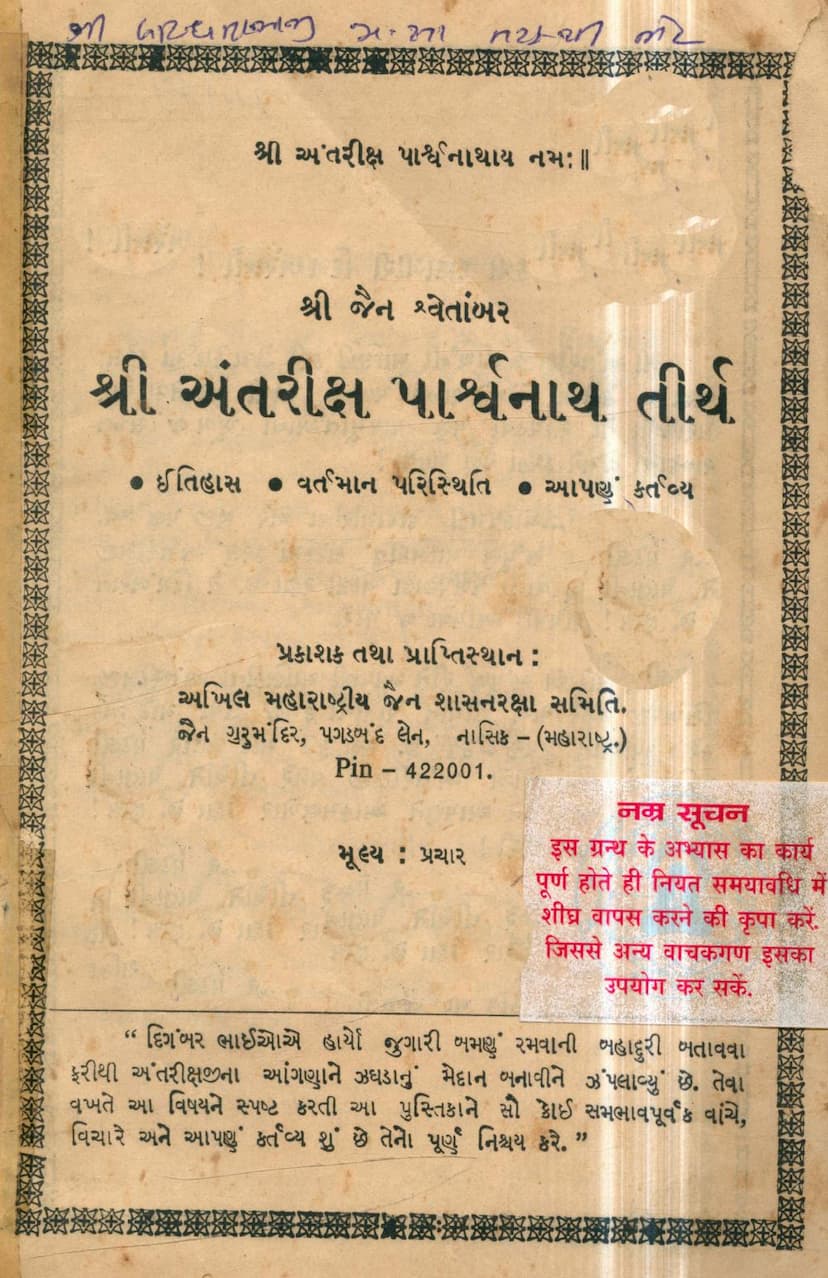Antariksh Parshwanath Tirth
Added to library: September 1, 2025

Summary
Here's a comprehensive summary of the Jain text "Antariksh Parshwanath Tirth," focusing on the history, current situation, and the responsibilities of the community:
This book, published by the Akhil Maharashtriya Jain Shasanraksha Samiti, details the historical and ongoing disputes surrounding the Antariksha Parshwanath Tirth (temple) in Shirpur, India. The central issue is the claim of ownership and management of this ancient Shvetambar Jain temple, with a particular focus on the idol of Shri Antariksha Parshwanath.
Historical Context and Legal Battles:
- Ancient Shvetambar Tirth: The text establishes that Shirpur is an ancient Shvetambar Jain pilgrimage site, managed by Shvetambar custodians for centuries. The main idol, Shri Antariksha Parshwanath, is described as miraculous and floating above the ground.
- Digambar Interference: The primary conflict arises from the Digambar sect's attempts to assert ownership and control over the temple and its properties, often through legal means and, as the text alleges, through forceful and unauthorized actions.
- 1905 Agreement: An agreement was reached in 1905 between the Shvetambar and Digambar communities regarding the worship of the idol. The Shvetambars worship the idol with ornaments, tilak, and crowns, while the Digambars worship it in a state without these adornments. Both were granted rights to worship according to their respective customs.
- The "Chiseling" Incident: A pivotal event occurred in 1908 when, during the process of repainting (lep) the idol, the Digambar community allegedly chiseled off the idol's traditional Shvetambar markings (kandare and kachhota). This act caused immense hurt to the Shvetambar community and led to further legal disputes.
- Extensive Litigation: The book extensively details a series of legal cases spanning decades, from the early 20th century to the mid-20th century. These cases, heard in various courts including the Nagpur High Court and the Privy Council in London, consistently favored the Shvetambar community.
- Key Court Rulings: The judgments affirmed the Shvetambar community's exclusive right to manage the temple and its properties. The courts also confirmed that the idol was originally a Shvetambar idol, possessing Shvetambar characteristics (like waistbands and loincloths) and that the Shvetambars had the right to apply the "lep" (plastering/painting) to the idol.
- Digambar Appeals and Defeats: Despite numerous court losses, including appeals to the Privy Council, the Digambar community continued to challenge the Shvetambar rights, often attempting to obstruct renovation, management, and even daily rituals.
- Ongoing Interference: Even after the legal pronouncements, the Digambar community's interference continued. The text recounts instances of obstructing renovations, forcefully occupying spaces, installing Digambar idols and symbols within the Shvetambar temple, and even physically assaulting Shvetambar caretakers.
- Misuse of Legal Process: The book accuses the Digambar community of misusing legal processes, filing frivolous cases, and attempting to create chaos and confusion to achieve their objectives.
Current Situation and the Call to Action:
- Digambar "Aggression": The publication highlights the current "aggression" by the Digambar community, who are allegedly attempting to take over the temple through intimidation and continuous interference. They are described as having raised a substantial fund ("Dhruv-Kund") to pursue their claims.
- Community Responsibility: The book serves as a strong call to action for the Shvetambar Jain community. It emphasizes that defending their rightful heritage and the sanctity of the Tirth is a sacred duty.
- Establishment of the Samiti: To counter these ongoing challenges, the Akhil Maharashtriya Jain Shasanraksha Samiti (All Maharashtra Jain Governance Protection Committee) was established on a specific auspicious day in V.S. 2036 (corresponding to the late 1970s/early 1980s). The Samiti is registered as a religious trust and is actively engaged in protecting the Antariksha Tirth.
- Request for Support: The Samiti appeals to all members of the Shvetambar community – leaders, monks, nuns, devotees, and philanthropists – to contribute their time, effort, and financial resources to this cause. They are urged to donate to the trust, which will be used according to scriptural guidelines.
- Spiritual Support: The Samiti also seeks the blessings and guidance of respected Jain Acharyas and monks.
- The Need for Awareness: The text aims to educate the Jain public about the true history of the Tirth, the legal victories of the Shvetambar community, and the persistent, often unfounded, claims and actions of the Digambar community. It warns against the Digambar propaganda that seeks to mislead the public.
Key Themes and Concerns:
- Protection of Heritage: The core message is the urgent need to protect a significant Jain pilgrimage site from what the Shvetambar community views as an unjust and aggressive takeover.
- Truth vs. Misinformation: The book positions itself as a source of truth against the "false propaganda" spread by the Digambar community.
- Unity and Collective Action: It stresses the importance of unity and collective action within the Shvetambar community to safeguard their rights and their sacred sites.
- Spiritual and Material Loss: The text laments the financial and emotional toll these disputes have taken on the Shvetambar community and the temple's resources, which could otherwise be used for development and spiritual activities.
- Maintaining Jain Principles: It highlights the irony and tragedy of conflict within the Jain community itself, emphasizing that such disputes go against the core principles of Jainism.
In essence, "Antariksh Parshwanath Tirth" is a historical account and a fervent appeal from the Shvetambar Jain community to defend their rightful claim and management of the Antariksha Parshwanath Tirth, presenting a detailed narrative of legal battles and ongoing efforts to protect this holy site from what they perceive as relentless interference and aggression.